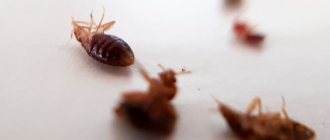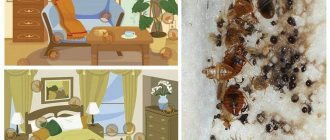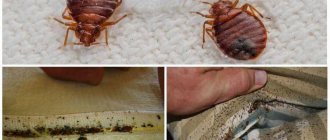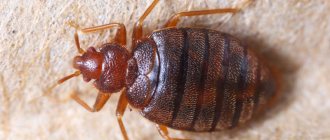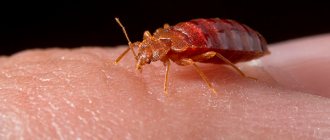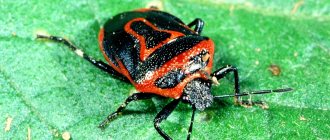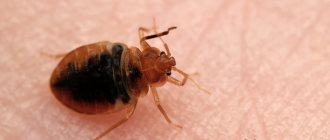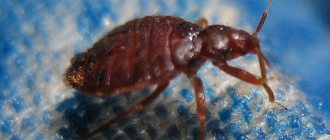- By Vil Malinoshevsky
- About bedbugs
To remove bedbugs from your apartment or house once and for all, you need to know how they are transmitted and how they get there. Our subscribers constantly complain that they have already poisoned bedbugs and they disappeared for a month or two, and then appeared again. At night, the parasites began to bite them again, and they, in turn, went to buy new aerosols and re-spray their homes with them. The next disinfestation also turned out to be effective, but, as a rule, not for long. After a while, everything started all over again.
This is due to the fact that bedbugs easily move from apartment to apartment through different crevices. Also, sometimes the residents themselves carry them on their clothes. As a result, people poison them and destroy them, but soon new ones appear in their place. Thus, disinsection must be repeated regularly. However, if you can find out how bedbugs get into the house and seal their passages, then you will be able to get rid of the parasites for good.
To some extent, knowing exactly how bedbugs enter an apartment is more important than knowing how to destroy them. Professional exterminators can do the latter for you, but only you can protect your home from re-infestation. In addition, there are even special traps that allow you not to poison bedbugs, but simply catch them all. However, they are only effective when the main nests of parasites and the ways of their penetration into the apartment are found.
Why do bedbugs crawl out of an infested apartment?
In the first case, bedbugs begin to move and invade new premises when their population in the first case increases significantly. Then some individuals begin to look for new sources of food and places to create nests, where they will not have so much competition. As a result, they find cracks in the walls, through which they move to their neighbors. Bedbugs run very quickly, so at night in just a few hours they can easily cover the space of several rooms or a landing.
A bedbug on the clothes on which it was accidentally brought into the apartment
Two reasons can provoke bedbugs to migrate: hunger or some other danger. Most often, they begin to scatter if residents carry out pest control. They can also spread among neighbors if the owners of the apartment where they live have gone on vacation for a month or more. As a result, if bedbugs have even the slightest opportunity to enter your apartment, they will definitely do so.
Main reasons for migration
The movement of blood-sucking insects is a forced or natural process.
Parasites enter an apartment in the following ways:
- on the clothes and shoes of family members;
- when purchasing contaminated furniture or items;
- on pet fur.
Migration of bedbugs occurs during renovation of premises or during the period of disinfestation measures. Relocation of bedding species is carried out in the dark. Only during disinfestation do insects migrate during the day. The movement of blood-sucking individuals can also occur along the external walls of multi-story buildings.
The main reason for the movement of bedbugs is hunger, which threatens their existence. The migration of laundry parasites from neighbors is a common process in a multi-story building.
How bedbugs are transmitted by people themselves
In other cases, people themselves bring bedbugs into their homes on their clothes, bags and other things. In this way, infection occurs no less often than when insects move from neighbors.
Bed bugs are not stationary parasites, that is, like mosquitoes, they do not live on human bodies. They bite a person, suck blood and run away to their hiding places. Thus, one person cannot become infected with bedbugs from another person. However, these parasites are often carried on clothing.
Most often, such an infestation occurs when a person goes on vacation or a business trip and spends the night in a hotel where bedbugs live. At night they can bite him and then return to their hiding places. In this case, one or two bedbugs may become entangled in clothing and remain in it. In the morning, getting out of bed, a person can take off these things, put them in a suitcase and go home. As a result, insects will also make the journey. If all items are not washed at high temperatures immediately, the parasites will get out of them and crawl somewhere under the baseboards. Also, during a trip, they can get out of things and get into the cracks in the bag, and then at home they can get out of them and run away. As a result, after a few days, the parasites will smell the carbon dioxide exhaled by people and climb into their bed to bite.
A person will be lucky if he brings home one male or nymph in this way, which will die in a couple of weeks, before any of the residents have time to get scared. However, if a fertilized female or several bugs get into the house, then soon there will be a lot of them in the apartment.
Likewise, a bug can come to your home directly on your outerwear or shoes. You can bring him in even by visiting an infected premises.
It is almost impossible to get bedbugs on your body. Having bitten, they tend to immediately run away, especially if the person starts to move. This is how they end up in the folds of clothes, bags and suitcases.
This is probably the most common way of infecting an apartment or house with parasites, when they are carried by people and do not escape from neighbors. People often travel to different places, so insects are much more likely to get into a new room on their things than, for example, on furniture or household appliances, which are transported or bought used less often.
Because of this, it is dangerous to visit houses where bedbugs live, and it is even more undesirable to spend the night in such places. The scary thing is not that you will be bitten at night, but that some parasites will definitely get into your things and then get into your home, thereby complicating your life at least for the next few months.
In addition, bedbugs are carried with old furniture, refrigerators, computers and other equipment. Very often, it is in such objects that parasites make their nests. There can be countless of them in one sofa or bed. Having brought it into your home, you can then spend a very long time persecuting these parasites.
Our subscribers often complain that they got bedbugs after purchasing old furniture. Some people, having learned that it is infected, rush to throw it away as soon as possible, but this does not solve the problem. Insects quickly spread throughout the room, penetrating under baseboards, into the cracks between wallpaper and other secluded places. As a result, in order to remove them, people have to disinfest the entire apartment.
One day we were approached by a master restorer who specializes in restoring antique furniture. Once, an old sofa was brought to his workshop, which is located in a private house next to the living quarters. A few weeks after this, residents began complaining of bedbug bites. They tried to get rid of the parasites for a year. Difficulties arose due to the fact that insects crawled throughout the house, climbed into other furniture and under the boards in the floor. They were destroyed only after several professional treatments and the use of expensive means.
In general, if you see a good sofa left by someone else on the street, do not rush to take it home. There is a high probability that they got rid of it precisely because of bedbugs. For example, in America, when contaminated furniture is thrown away, a special mark is made on it. In our country, of course, no one does this, so parasites taken out of the house along with the furniture quite often find new owners and cozy housing.
There are many similar stories. For example, a computer repairman brought home someone else's laptop. A few days later he took it apart and found a nest of bedbugs inside. He shook them into the toilet and flushed them. The laptop was then quickly assembled and returned to the owner. A week later, he had to remember this incident, when, after sleep, marks from bedbug bites began to appear on his body.
In exactly the same way, bedbugs get into the house along with mattresses, carpets, baby strollers, toys, indoor plants and other things purchased on the secondary market.
Nowadays, people can travel thousands of kilometers in a day. Bedbugs can also mix with them. You can bring them on clothes to your home from an apartment on the street next door or, for example, bring them to Moscow from a hotel in Bali.
Bedbug nest on the inside of the sofa
In addition, you can pick up bedbugs on public transport. Drivers of regular buses and trucks often contact us. Parasites infest interiors and create their nests in or near the seats. At night, they emerge from their hiding places and bite passengers traveling long distances. Some suck blood and successfully return to their shelter, and some crawl into the pockets, bags and suitcases of travelers. Thus, they end up at someone's home and quickly begin to explore new territories.
We are also often contacted by hotel and hostel owners. They complain that they have already carried out pest control many times, but over time, bedbugs appear again. No matter how sad it may be, in such establishments it is almost impossible to get rid of parasites forever. The fact is that a variety of people constantly come to hotels and periodically someone brings bedbugs there with their belongings. Because of this, even the most thorough treatment gives only temporary results. As a result of its implementation, the insects die, and after some time they appear because they were brought in again by someone, and not because the disinfestation was ineffective.
Common Myths
Many people feel fear at the mere mention of blood-sucking parasites and willingly believe various stories about bed bugs.
The following are popular among them:
- Household parasites carry dangerous diseases. This statement is not true. A person who is constantly bitten by bedbugs develops symptoms: itching at the site of the skin puncture, insomnia, allergic reactions on the skin. Parasite bites negatively affect the state of the nervous system, symptoms of depression often develop, a person feels anxiety, and panic seizes him. Scientists have found that domestic bloodsuckers are not carriers of dangerous diseases.
- The small size of insects makes them difficult to detect with the naked eye. This is an incorrect statement, because a person with normal vision can see the parasite. The body of the bug is slightly flattened, but after eating it increases in size, then the insect is easy to notice in the bed or behind the carpet.
- Linen specimens live only in beds. An erroneous statement, because Parasites are found not only in the folds of bedding, they live in curtains, the seams of chairs and under the upholstery of the sofa.
Bed bugs fly and jump
Bed parasites only move slowly over short distances, but are unable to fly or jump. A hungry insect covers a distance of 30 cm in 60 seconds. Having eaten, the bug becomes less mobile, because his body increases in size several times.
The size of a well-fed bug increases significantly, it becomes more noticeable and inactive.
The pest crawls a short distance 2.5 times slower.
There is a myth among owners of comfortable apartments and country houses that a blood-sucking insect can jump and fly. The reason for the misconceptions is related to the behavior of other representatives belonging to the order Hemiptera. Among them there are individuals that make jumps and can fly in air currents over long distances.
The house bug has a special body structure. 6 small limbs do not allow the insect to make even short jumps. The wings, which fit tightly to the upper part of the body, are in their infancy. They can only be seen upon closer inspection.
When studying information about bedbugs, it becomes clear that blood-sucking parasites can move around the apartment only by crawling from one place to another.
How did bedbugs end up in your house?
When bedbugs appear in an apartment, it is very important to understand whether they were introduced accidentally or came from neighbors. When understanding this, you need to take into account several nuances.
Firstly, bedbugs are almost never carried by pets. In an apartment where people live, bedbugs bite them first, without touching their pets. It is difficult for parasites to get through the fur to their skin. In addition, cats and dogs have rougher skin than humans, making it difficult for insects to bite through. However, they can still bite animals, but only in severe hunger, when there are no people nearby. This happens extremely rarely, because pets do not live in empty apartments. In cases where bedbugs do attack a cat or dog, they leave the body very quickly after the bite. When the animal begins to move, the bug tries to quickly run away and hide in its shelter. Therefore, the likelihood that an animal will bring bedbugs into the house is almost zero. With people the situation is different. Having bitten a person, the bug also strives to leave his body and return to its place, but along the way it can become entangled in clothing and remain in it. Animals do not have clothing, so they cannot transfer parasites this way. It should be taken into account that bedbugs can live in beds, carriers, scratching posts and other objects. When moving them from one room to another, you can also move the pasazites.
Bedbug eggs and larvae on the back of the carpet
Secondly, bedbugs almost never leave living spaces, even in the warm season. This is unnatural for them. In the wild, they live in animal burrows and caves, but not in the open air. This means that only people carry them from one building to another. Consequently, they can only get into a private house in this way. In rare cases, they can enter the house from the chicken coop if they are very close. In chicken coops, bedbugs reproduce very quickly, parasitizing birds, so their appearance in a nearby house is not uncommon. In general, bedbugs can cover a distance of 10-20 meters, but they will not travel 30-40 meters or more.
Pest running speed
Bedbugs move at a speed of 1 m per minute. Small larvae move more slowly, so they live near human sleeping places so as not to move long distances at night.
House bugs move exclusively in one way - crawling from place to place.
During the migration period, domestic parasites travel long distances. In 24 hours, moving through a ventilation shaft, bedbugs crawl several hundred meters.
Domestic bloodsuckers move slower than cockroaches. Predatory bugs of the Antacoris species, living in tropical countries, move faster than linen bugs and attack sedentary insects - mollusks, caterpillars, larvae.
Do exterminators tolerate bedbugs?
Another question we are often asked is: can exterminators themselves accidentally or intentionally transfer bedbugs from one room to another? Due to their duty, they have to constantly visit apartments in which huge numbers of these parasites live. Therefore, it can be assumed that they can get into the things and bags of specialists.
In fact, the risk of an exterminator bringing in bedbugs is virtually zero. Firstly, his work uniform, as well as all bags and equipment, are treated with insecticides. Because of this, even if bedbugs accidentally get somewhere, they quickly die and are definitely not transferred to the next clients. Secondly, an exterminator comes to an apartment with bedbugs in order to destroy them. He treats all surfaces in the house with potent drugs that quickly kill bedbugs. In such conditions, they simply do not physically have the opportunity to get into the bag or pockets of a specialist’s clothing.
Sometimes they express to us completely absurd ideas. Some people suggest that exterminators deliberately spread bedbugs into residential buildings so that their residents will then contact the company for help. They say that exterminators catch bedbugs in infested rooms and then plant them under the doors of a randomly selected apartment.
This is theoretically possible and this fact cannot be refuted with one hundred percent certainty. Maybe someone once tried to infect an apartment in this way, and it was not necessarily the exterminators who did it. Regarding the activities of the latter, let's think logically. The main problem of pest control services is high competition, not a lack of clients. The likelihood that after deliberately planting bedbugs in a particular house, its residents will turn to this particular company is extremely low. Therefore, it makes no sense for exterminators to increase the number of infected apartments using this method. There are already a lot of them, much more than all the companies in the city could clean up. In addition, people themselves successfully cope with the spread of bedbugs by constantly transporting them from one room to another.
Due to suspicions that exterminators are spreading bedbugs, when parasites appear in the house, residents first look at the notices posted nearby and refuse to contact these services. They assume that their employees caused the appearance of insects in their home. To get rid of them, residents begin to look for other companies or try to poison the bedbugs themselves. In general, it makes no sense for exterminators to plant parasites on someone, because competition between companies is very strong, and the likelihood that after an apartment is infested with bedbugs, its residents will turn to a specific company is very low. The main task for exterminators is to sell their services and work effectively to get clients, and not to increase their total number.
Interesting Facts
Residents of apartment buildings should know some signs of the presence of linen bloodsuckers indoors:
- The bug has an odor reminiscent of coriander.
- An indisputable sign of the presence of insects is complaints from family members about the appearance of numerous bites located on the body.
- Peak food intake for parasites is from 0:00 to 05:00 hours.
- An insect that feeds on blood can go without food for 2 months.
- An adult quickly finds a food source, because senses the warmth of the human body and the presence of carbon dioxide in the exhaled air.
- A bug bite causes an allergic reaction in 80% of people.
- The insect is often the cause of anemia in young children.
- Triatomidae are carriers of the causative agent of Chagas disease or American trypanosomiasis.
- An increase in the number of blood-sucking parasites is facilitated by the formation of populations resistant to the effects of insecticides, for example, 25% of cypermethrin, which is part of disinfectants.
There are many ways to combat home bugs, which allow you to destroy all blood-sucking insects living in the room.
Source
Danger
Epidemiological observations of bed bugs have shown that the threat of transmitting infections is not great , although it is known that they can retain pathogens of plague, typhus, tularemia, and viral hepatitis B. But these insects cause the greatest harm to people with their bites, depriving them of normal sleep and rest . This negatively affects performance and general well-being. Also, bedbug injections can lead to scratching and skin diseases .
We don’t end our search on the bed...
In our practice, we were sometimes able to find bedbugs in completely unexpected places. I’m not talking about baseboards and under parquet floors - they are almost always there. But it happens that their nests are found behind books on shelves and behind the shelves themselves, inside laptops and computer system units, behind pictures on the walls, in safes, in sockets, in old things that people have not worn for a long time.
Simply put, the bed is just the beginning. This is where you discover bedbugs and this is where you start looking for them. And where you will find all the other nests is very difficult to say. The main thing is to understand that bedbugs are not only infested in beds. It’s very, very rare that this happens: they are in the bed, but not anywhere else.
Now. You found bedbugs in the bed. This means that you need to look for them in the entire room, and preferably in the entire apartment. Here you need to inspect all the cracks, holes, cavities where they can physically get into. The following rule works here: the more difficult it is for you to get to a particular bedbug shelter, the more likely they are to have a nest there.
In our practice, we were sometimes able to find bedbugs in completely unexpected places. I’m not talking about baseboards and under parquet floors - they are almost always there. But it happens that their nests are found behind books on shelves and behind the shelves themselves, inside laptops and computer system units, behind pictures on the walls, in safes, in sockets, in old things that people have not worn for a long time.
It is not possible to get rid of ticks completely and forever; the main rule is to keep the house clean and carefully care for bedding.
What will help get rid of dust microorganisms in pillows:
- Ideally, replace down and feather products with accessories with synthetic filling: padding polyester, holofiber, comforter, which must be washed once every six months at temperatures above 50 °C.
- If you don’t want to part with natural materials, or for children, you can choose an alternative with the following fillings: buckwheat husk, bamboo or coconut fiber, latex.
Fans of fluff and feathers can bring out “guests” in several ways:
- Airing the pillows in the air for at least 5–6 hours gives a temporary effect. In winter - in frost, in summer - in direct sunlight. This method does not work for long, since tick eggs are insensitive to heat and cold, only adult individuals die.
- Once a year it is worth disinfecting such products with special dry cleaning products.
- You can also clean the pillow yourself. The bedstead needs to be washed, ironed (or replaced). Down filling - treat with a soap solution (100 g of laundry soap, 100 g of ammonia per 10 liters of water), rinse thoroughly and dry, then put the product back together.
It is worth noting that it is impossible to get rid of dust mites by cleaning only the bed linen. Additionally, you need to weaken the provoking factor:
- sort out deposits of soft toys;
- reduce the number of carpets and curtains;
- Follow the rules for storing winter clothes.
Also, during wet cleaning, you can add special antiparasitic agents.
The process of parasite reproduction
Bed bugs reproduce much faster than other insects. They become sexually mature pests 30 days after emerging from the egg. The rate of development can only be affected by room temperature. At low temperatures the larvae grow more slowly. One female, during her entire adult life, can lay up to 400 eggs.
The mating process takes place in a traumatic form. Males pierce the female's body and inject sperm into the abdominal cavity. After such contact, the female carries the seed within herself for a long time and lays 5-6 eggs daily. If the mother does not receive blood for a long time, her body begins to absorb the larvae that have not yet developed inside.
Drugs and preventive measures
Regular washing of bedding and ironing helps to effectively cope with parasites. But not all fabrics can be washed at high temperatures and ironed. To neutralize allergens and cope with mites at any temperature, a special Acaril liquid is added to the washing machine. The same product, released in powder form, can be used to clean carpets.
Wet cleaning is the main weapon in the fight against dust and its inhabitants. Its effect can be enhanced by adding special All-Rug shampoo to the water. The product is sold as a concentrate and can be used to clean natural and synthetic pile of furniture and carpets. It is used in a washing vacuum cleaner and for manual cleaning. The drug is diluted 1:30 in the first month, then a solution of 1:60 is sufficient. The product removes dirt, allergens and mold well, and has a pleasant aroma.
Allergoff spray is capable of destroying parasites at any stage of development. The aerosol form makes it easy to treat mattresses, blankets, carpets and upholstered furniture. The action of the acaricidal drug causes the death of mites in down pillows 1 hour after spraying. Bedding must be treated from all sides.
Spray "Akarosan" when sprayed, penetrates into the body of dust mites when feeding and through the chitinous shell. The main active ingredient of the drug is benzyl benzoate. The spray enlarges arthropod excrement, allowing it to be collected with a vacuum cleaner. Particles of the drug remain in the structure of the treated surface for a long time. They have a detrimental effect on subsequent generations of ticks. The protective effect of Akarosan is 6-9 months.
Folk recipe
There are specially developed formulations that help fight feather mites. Sanitation services treat premises with solutions that are safe for people, but have a negative effect on insects. But you can also purchase anti-tick chemicals yourself, diluting them strictly according to the instructions. Effective drugs include:
- Tsifekos powder, which is diluted in water, eliminates feather mites for one month.
- Emulsion Sipaz means for disinfection in residential premises. Fights insects for 30 – 45 days.
- Based on medicinal herbs, there are sprays for treating bed linen that eliminate feather mites in three hours.
- Easy Air product, developed based on natural ingredients.
- Allerqoff spray for treating mattresses, carpets, and upholstered furniture helps reduce the number of mites.
We suggest you read: Can lice jump?
Atypical places
Let’s complete the list with those objects that bedbugs infest least often and where they hide only in exceptional cases.
Do they live in audio, video and computer technology? In my practice, I have never seen this happen, but I have heard that it happens. The system unit is warm and has a place to hide, and if a source of food regularly spends time nearby (especially if at night), then why not settle there.
Bedbugs are found in soft toys in approximately one case out of five hundred. In order for the bloodsuckers to set up their camp there, the toy must be constantly motionless near the infected bed, but even then the danger is small. Still, in such a situation, it is better to play it safe and do preventive treatment.
Ø Bathroom
Ø Toilet
Ø Hallway
Ø Kitchen
Ø Balcony
Ø Garage
Michael F. Potter. Bed Bugs // Extension Entomologist University of Kentucky College of Agriculture

